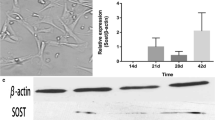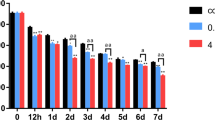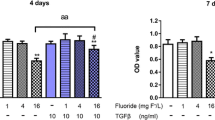Summary
Skeletal fluorosis is a chronically metabolic bone disease with extensive hyperostosis osteosclerosis caused by long time exposure to fluoride. Skeletal fluorosis brings about a series of abnormal changes of the extremity, such as joint pain, joint stiffness, bone deformity, etc. Differentiation and maturation of osteoblasts were regulated by osteoclasts via Sema4D/Plexin-B1 signaling pathway. Furthermore, the differentiation and maturation of osteoclasts are conducted by osteoblasts via RANKL/RANK/OPG pathway. Both of these processes form a feedback circuit which is a key link in skeletal fluorosis. In this study, an osteoblast-osteoclast co-culture model in vitro was developed to illustrate the mechanism of skeletal fluorosis. With the increase of fluoride concentration, the expression level of Sema4D was decreased and TGF-β1 was increased continuously. OPG/RANKL mRNA level, however, increased gradually. On the basis of that, the inhibition of Sema4D/Plexin-B1/RhoA/ROCK signaling pathway caused by fluoride promoted the level of TGF-β1 and activated the proliferation of osteoblasts. In addition, osteroprotegerin (OPG) secreted by osteoblasts was up-regulated by fluoride. The competitive combination of OPG and RANKL was strengthened and the combination of RANKL and RANK was hindered. And then the differentiation and maturation of osteoclasts were inhibited, and bone absorption was weakened, leading to skeletal fluorosis.
Similar content being viewed by others
References
Liu XL, Li CC, Liu KJ, et al. The influence of fluoride on the expression of inhibitors of Wnt/β-catenin signaling pathway in rat skin fibroblast cells. Biol Trace Elem Res, 2012,148(1):117–121
Mavrogenis AF, Soucacos PN, Papagelopoulos PJ. Heterotopic ossification revisited. Orthopedics, 2011,34(3): 177
Xu H, Jin XQ, Jing L, et al. Effect of sodium fluoride on the expression of bcl-2 family and osteopontin in rat renal tubular cells. Biol Trace Elem Res, 2006,109(1):55–60
Shashi A, Kumar M, Bhardwaj M. Incidence of skeletal deformities in endemic fluorosis. Trop Doct, 2008,38(4):231–233
Negishi-Koga T, Shinohara M, Komatsu N, et al. Suppression of bone formation by osteoclastic expression of semaphorin 4D. Nat Med, 2011,17(11):1473–1480
Hirschberg A, Deng S, Korostylev A, et al. Gene deletion mutants reveal a role for semaphorin receptors of the plexin-B family in mechanisms underlying corticogenesis. Mol Cell Biol, 2010,30(3):764–780
Yang S, Tian YS, Lee YJ, et al. Mechanisms by which the inhibition of specific intracellular signaling pathways increase osteoblast proliferation on apatite surfaces. Biomaterials, 2011,32(11):2851–2861
Nogi T, Yasui N, Mihara E. Structural basis for semaphoring signaling through the plexin receptor. Nature, 2010,467(7319):1123–1127
Tang Y, Wu XW, Lei WQ, et al. TGF-beta1-induced migration of bone mesenchymal stem cells couples bone resorption with formation. Nat Med, 2009,15(7):757–765
Torra M, Rodamilans M, Corbella J. Normal range in anonexposed population. Biol Trace Elem Res, 1998,63 (1):67–71
Song YE, Tan H, Liu KJ, et al. Effect on bone metabolismindicators ALP, BALP and BGP of fluoride exposure. Environ Health Prev Med, 2011,16(3):158–163
Ba Y, Zhu JY, Yang YJ, et al. Serum calciotropic hormone levels,and dental fluorisis in children exposed to different concent rations offluoride andiodine in drinking water. Chin Med J, 2010,123(6):675–679
Shashi A, Bhardwaj M. Study on blood biochemical diagnostic indices for hepatic function biomarkers in endemic skeletal fluorosis. Biol Trace Elem Res, 2011,143(2):803–814
Hussain I, Arif M, Hussain J. Fluoride contamination in drinking water in rural habitations of Central Rajasthan. India. Environ Monit Assess, 2011,184(8):5151–5158
Luo K, Liu Y, Li H. Fluoride content and distribution pattern in groundwater of eastern Yunnan and western Guizhou, China. Environ Geochem Health, 2012,34(1):89–101
Gonnelli S1, Montagnani A, Caffarelli C, et al. Osteoprotegerin (OPG) and receptor activator of NF-kB ligand (RANK-L) serum levels in patients on chronic hemodialysis. J Endocrinol Invest. 2005,28(6):534–539
Leah E. Bone: Finding that osteoclasts repel osteoblast activity through Sema4D reveals novel target for boneboosting therapies. Nat Rev Rheumatol, 2011,7(12):681
Wu XY, Wu XP, Luo XH, et al. The relationship between the levels of gonadotropic hormones and OPG, leptin, TGF-β1 and TGF-β2 in Chinese adult women. Clin Chim Acta, 2010,411(17–18):1296–1305
Kikuta J, Ishii M. In vivo imaging of mature osteoclasts and RANKL signaling. Clin Calcium, 2011,21(8):1181–1185
Nakashima T, Takayanagi H. RANKL signal and osteoimmunology. Clin Calcium, 2011,21(8):1131–1140
Mizoguchi T. RANKL signaling and bone diseases, quiescent osteoclast precursors and RANKL signaling. Clin Calcium, 2011,21(8):1187–1192
Jurado S, Garcia-Giralt N, Díez-Pérez A, et al. Effect of IL-beta1, PGE (2), and TGF-beta1 on the expression of OPG and RANKL in normal and osteoporotic primary human osteoblasts. J Cell Biochem, 2010,110(2):304–310
Cao X. Targeting osteoclast-osteoblast communication. Nat Med, 2011,17(11):1344–1346
Tanaka H, Mine T, Ogasa H, et al. Expression of RANKL/OPG during bone remodeling in vivo. Biochem Biophys Res Commun, 2011,411(4):690–694
Author information
Authors and Affiliations
Corresponding author
Additional information
This project was suppooted by the National Natural Science Foundation of China (No. 81372941).
Rights and permissions
About this article
Cite this article
Liu, Xl., Song, J., Liu, Kj. et al. Role of inhibition of osteogenesis function by Sema4D/Plexin-B1 signaling pathway in skeletal fluorosis in vitro . J. Huazhong Univ. Sci. Technol. [Med. Sci.] 35, 712–715 (2015). https://doi.org/10.1007/s11596-015-1495-1
Received:
Revised:
Published:
Issue Date:
DOI: https://doi.org/10.1007/s11596-015-1495-1




